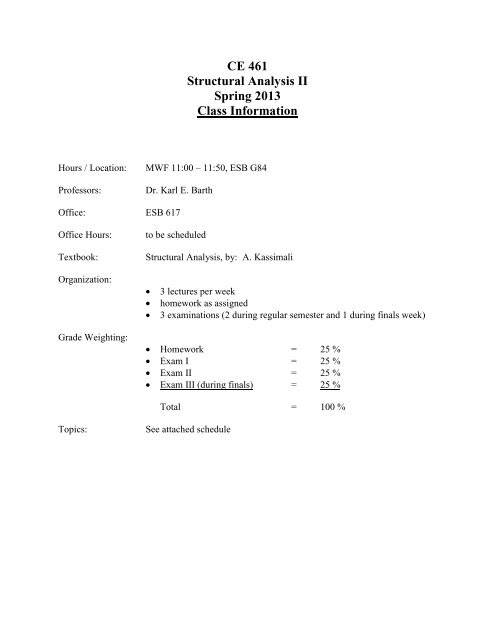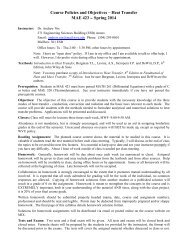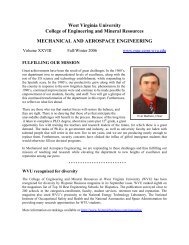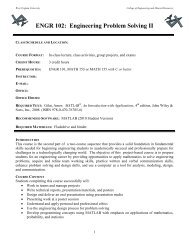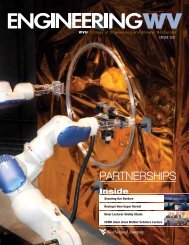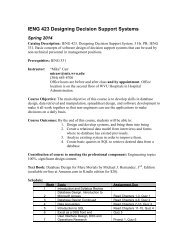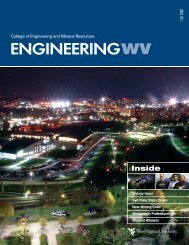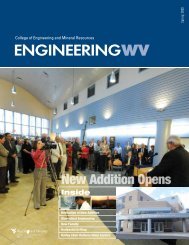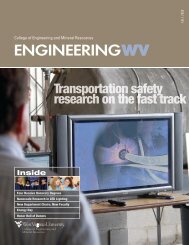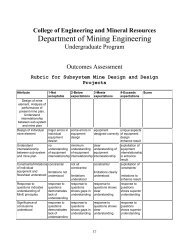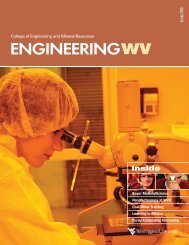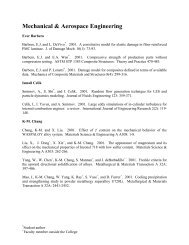CE 461 Structural Analysis II Spring 2013 Class Information
CE 461 Structural Analysis II Spring 2013 Class Information
CE 461 Structural Analysis II Spring 2013 Class Information
You also want an ePaper? Increase the reach of your titles
YUMPU automatically turns print PDFs into web optimized ePapers that Google loves.
<strong>CE</strong> <strong>461</strong><br />
<strong>Structural</strong> <strong>Analysis</strong> <strong>II</strong><br />
<strong>Spring</strong> <strong>2013</strong><br />
<strong>Class</strong> <strong>Information</strong><br />
Hours / Location:<br />
Professors:<br />
MWF 11:00 – 11:50, ESB G84<br />
Dr. Karl E. Barth<br />
Office: ESB 617<br />
Office Hours:<br />
Textbook:<br />
Organization:<br />
Grade Weighting:<br />
to be scheduled<br />
<strong>Structural</strong> <strong>Analysis</strong>, by: A. Kassimali<br />
• 3 lectures per week<br />
• homework as assigned<br />
• 3 examinations (2 during regular semester and 1 during finals week)<br />
• Homework = 25 %<br />
• Exam I = 25 %<br />
• Exam <strong>II</strong> = 25 %<br />
• Exam <strong>II</strong>I (during finals) = 25 %<br />
Total = 100 %<br />
Topics:<br />
See attached schedule
Course Statement:<br />
An accurate prediction of the behavior of a structure subjected to service loads and occasional extreme<br />
loads is indispensable in designing new structures and evaluating existing ones. This behavior is defined<br />
by the deformations and forces produced within the structure. The process of determining these values is<br />
known as structural analysis. The accuracy and reliability of such an analysis is purely a function of how<br />
well its inherent assumptions and approximations match the actual "real-world" conditions.<br />
This course will provide an in-depth study of various methods for the analysis of statically indeterminate<br />
structures. We will begin with the analysis of statically determinate structures subjected to moving loads,<br />
which is essential for the analysis of bridge and crane structures as well as for the determination of pattern<br />
loading. We will then present several classical methods of indeterminate analysis and finally end with the<br />
coverage of the matrix stiffness methods, presently the leading method used in the structural engineering<br />
profession.<br />
Homework Policy:<br />
• Your name, course number, problem number, and due date must appear on all homework<br />
• Successive pages of multiple page sets must be initialed and should have the pagination (i.e., 1/3,<br />
2/3, 3/3, etc.) in the upper right-hand corner of the page<br />
• All assignments are to be done NEATLY using<br />
‣ Pencil<br />
‣ Engineering paper<br />
• each problem should be started on a new sheet of engineering paper<br />
• only one side of the paper is to be used (the lighter side)<br />
‣ Straight edges must be used for all figures<br />
• Multiple-page sets are to be stapled together in the upper left hand corner<br />
• Late homework will not be accepted<br />
Examination Policy:<br />
• Exams will be focused on specific areas of material coverage rather than being comprehensive.<br />
• Exams will be closed textbook and closed notes, however we will make use of appropriate sections of<br />
the AISC specifications.<br />
• You are to work on one side of the paper only on your exam sheets.<br />
• In the event that you question the grading of an exam problem, you must write an “appeal”<br />
summarizing your concerns, staple this to your exam, and submit this to the instructor. Note that the<br />
appeal should be typewritten and must be filed no later than, but inclusive of, the second class period<br />
following the return of the exam.<br />
Attendance Policy:<br />
• You are expected to attend class.
<strong>CE</strong> <strong>461</strong> – <strong>Structural</strong> <strong>Analysis</strong> <strong>II</strong> (<strong>Spring</strong> <strong>2013</strong>)<br />
Tentative Schedule<br />
Week <strong>Class</strong> Dates <strong>Class</strong> Topics<br />
1 01/14, 01/16, 01/18 Introduction<br />
2 01/21, 01/23, 01/25<br />
Influence Lines<br />
No <strong>Class</strong> 01/21 (Martin Luther King Jr. Day)<br />
3 01/28, 01/30, 02/01 Influence Lines & Approximate Frame <strong>Analysis</strong><br />
4 02/04, 02/06, 02/08 Moment Distribution Method<br />
5 02/11, 02/13, 02/15 Moment Distribution Method & Cables/Arches<br />
6 02/18, 02/20, 02/22<br />
Virtual Work Rev. & Method of Cons. Def.<br />
*Exam 1*<br />
7 02/25, 02/27, 03/01 Method of Consistent Deformations<br />
8 03/04, 03/06, 03/08 Method of Consistent Deformations & Matrix Algebra<br />
9 03/11, 03/13, 03/15 Matrix Stiffness Method (Introduction & Axial Elem.)<br />
10 03/18, 03/20, 03/22<br />
Matrix Stiffness Method (Axial Elem. & Assembly)<br />
*Exam 2*<br />
11 03/25 03/27, 03/29 No <strong>Class</strong>es (<strong>Spring</strong> Recess)<br />
12 04/01, 04/03, 04/05 Matrix Stiffness Method (Coordinate Transforms)<br />
13 04/08, 04/10, 04/12 Matrix Stiffness Method (Beam/Frame Elements)<br />
14 04/15, 04/17, 04/19 Matrix Stiffness Method (Indeterm. Frame <strong>Analysis</strong>)<br />
15 04/22, 04/24, 04/26 Computer Applications & Advanced Topics<br />
16 04/29, 05/01, 05/03 Computer Applications & Advanced Topics<br />
17<br />
Final Exam – Monday, May 6 th<br />
8:00 am – 10:00 am


